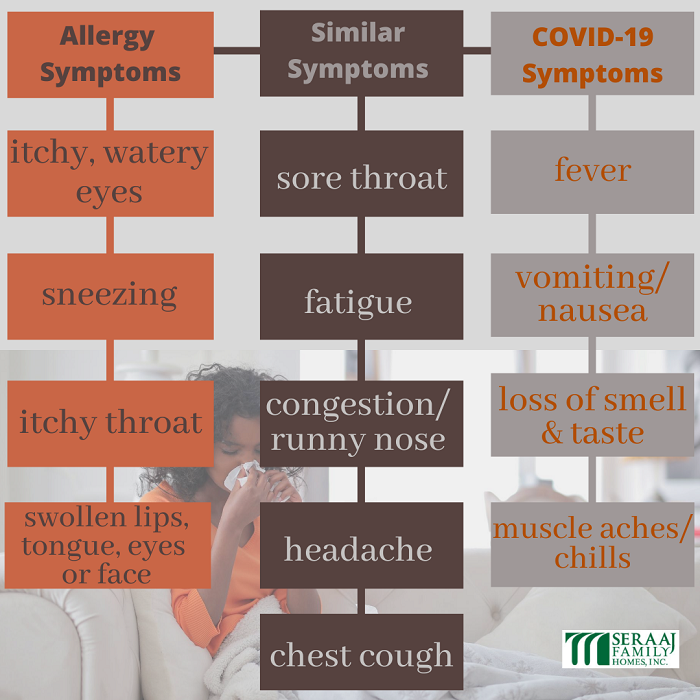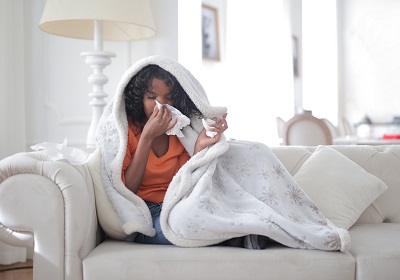By Intisar Seraaj
If you weren’t already a worrywart, this year might have pushed you towards being one. At the beginning of the pandemic, strangers and loved-ones alike might flinch or stare you down, fearful that you have COVID-19, even if you just had an allergy-induced cough or sneeze. With flu season and fall allergy season here, it’s hard to differentiate between the signs because they have several overlapping symptoms. With kids back in school and COVID-19 cases still on the rise in the U.S., it’s important to know the difference for your “peace of mind.”
Symptoms of Allergies vs. Symptoms of COVID-19
The Centers for Disease Control and Prevention (CDC) has provided some guidelines to help us distinguish between seasonal allergies and COVID-19. Here’s a chart that breaks down the similarities and the distinct symptoms. Hopefully, this will save you a doctor’s bill, but if you’re still unsure, please get tested.

Allergies can easily be mistaken for COVID-19 symptoms during this pandemic. Here’s how to differentiate between the two conditions. | Designed by Intisar Seraaj.
More About Allergy Season

COVID-19 has already forced us to get more creative with activities for the family. Many of us have fallen back on outdoor activities. Now with fall allergy season upon us, some of us may need to stick to inside activities to avoid triggering allergens. | Photo by Andrea Piacquadio from Pexels
Allergy season is split into several categories based on the allergens in your area. If you’re wondering which allergens are currently raging your area, Pollen.com lets you track pollen levels and see allergy forecasts based on your zip code. We’ve gotten through the tree and grass pollen seasons and now we’re in ragweed allergy season, which is believed to be the perpetrator behind many people’s allergy suffering during the autumn months. According to the American College of Allergy, Asthma & Immunology, ragweed pollen season starts in early August, lasts through October and reaches peak levels in mid-September.
To avoid having your allergies aggravated this season and mistaking your symptoms for COVID-19, follow these tips:
- Wearing a mask can help you ward off allergens and COVID-19.
- Avoid the outdoors as much as possible between roughly 10 a.m. and 3 p.m. local time.
- Spend time in the air conditioning.
- Wash your clothes as soon as you are done wearing them outdoors.
- Leave your shoes outside.
- Keep the windows closed.
- Have over-the-counter and prescription allergy medications ready to use.
- Vacuum the house every week with a vacuum cleaner that has a HEPA (high-efficiency particulate air) filter to capture microscopic particles for improved indoor air quality.
- Avoiding certain foods and herbs with proteins like those found in ragweed
According to the American College of Allergy, Asthma & Immunology, it’s possible for certain raw fruits, nuts and vegetables that contain the same pollen and proteins found on ragweed plants to provoke allergies. These are not traditional food allergies but eating these items during allergy season has the potential to cause similar symptoms. Pay attention to how your body reacts to these items if you choose to continue to consume them during the fall. Here are some of those food items that share the same pollen and proteins as ragweed plants:
- Fruits: bananas, watermelon, cantaloupe, cucumber, honeydew melon, and zucchini
- Seeds: sunflower seeds
- Vegetables: white potatoes
- Herbs: daisy, chamomile, and echinacea
It may be hard to remember all these tips but implementing as much of this information as possible will be worth it later. It’s all about avoiding allergy triggers while getting through allergy seasons, especially since we’re fighting a virus with similar symptoms. It’s a lot we’re fighting against right now! Being armed with information like this will help us to keep fighting for good health and holistic wellness one month at a time.

